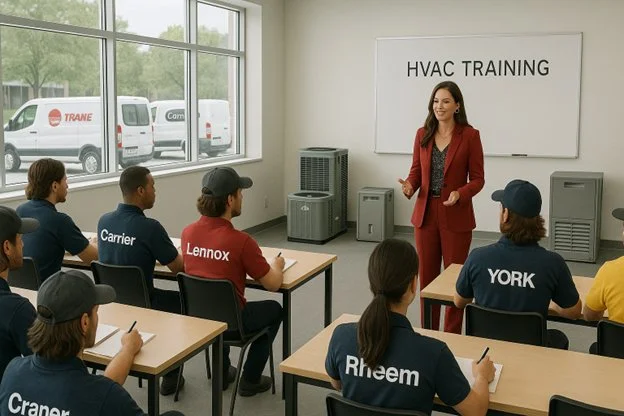HVAC Apprenticeship: Your Profitable Growth Blueprint
Ready to stop losing $150,000 to $250,000 annually due to technician turnover?
Schedule your complimentary apprenticeship strategy session today and build a talent pipeline that scales with your revenue goals.
According to the U.S. The Bureau of Labor Statistics, heating, air conditioning, and refrigeration mechanics and installers are expected to see “approximately 37,700 job openings annually between 2024 and 2034” (BLS.gov). Bureau of Labor Statistics
Most of these HVAC apprenticeship and technician openings happen because people retire or leave the field, not because the total number of jobs is growing.
For many HVAC companies making $5M–$30M in revenue, this isn't some future problem. It's happening right now.
As a certified executive and business coach specializing in HVAC growth, I hear from business owners across the US who are struggling with challenges that hinder their companies' growth.
Recently, a $12.0M HVAC contractor in Ashburn, VA, said it best when I spoke to him: "I can sell more jobs tomorrow, but I don't have enough technicians to handle the workload.”...and that’s the problem.
You can purchase new trucks, install advanced software, and establish an ideal warehouse. However, without technicians, growth comes to a halt.
More job ads will not solve this problem. You need a new strategy, and hiring an HVAC apprentice is one approach you can use.
Table of Contents
You're Stuck in the Middle - The Valley of Death
Companies between $5M and $30M face a unique problem.
Small firms can get by with the owner in the field. Huge national brands can offer big sign-on bonuses and relocation to attract top talent.
But you are in the middle. This is also referred to as a “valley of death,” where HVAC business owners often struggle to grow their companies.
Why? You will need anywhere between 25 and 100 technicians to continue growing. But you can't outbid everyone.
Even a small 10% turnover rate hurts.
If you have 50 technicians, you will need to replace 5 people per year.
With 100 techs, that’s 10 people a year.
Mathematically, if we estimate $15k–$25k to replace one experienced hire, then:
5 replacements = $75k–$125k
10 replacements = $150k–$250k
The average HVAC technician generates between $250,000 and $400,000 in annual revenue.
Lose one tech during summer or winter peak season? That adds up to $50,000 to $75,000 in missed work.
Lose multiple people? The damage adds up fast.
Let’s not forget that customer satisfaction and profitability also suffer when turnover rises.
New HVAC hires typically require 6–12 months to reach full productivity, which can lead to increased callbacks and warranty claims due to inexperience.
During that time, callbacks go up. Warranty claims increase. Bad online reviews pile up.
In BrightLocal’s 2023 Local Consumer Review Survey, “38% of consumers expected a local business to have a minimum average of 4 stars before they would even consider using it.” BrightLocal
HVAC Apprenticeship as a Workforce Strategy
Creating HVAC apprentice jobs in your company is a powerful workforce strategy for long-term growth
An HVAC apprenticeship program mixes classroom learning, online training, and real fieldwork. Apprentices come in and:
Carry tools.
Prep job sites.
Clean up.
Assist with installs.
Run checklists under supervision.
This frees up your senior techs to focus on more complex tasks. It speeds up jobs and brings in more revenue.
A good apprenticeship program lasts three or four years. Each year, apprentices receive approximately 2,000 hours of hands-on work experience and 144 hours of classroom instruction.
They start by earning 40–50% of a full technician’s wage and finish at 80–90%. This helps keep costs down while they learn and contribute to the team.
Stop losing technicians to competitors.
Claim your complimentary apprenticeship roadmap session and discover how to build loyalty, reduce callbacks, and scale profitably.
Why Owners Push Back
The data is clear, but owners still resist with the same recurring objections.
Fear of Poaching
In my experience coaching HVAC business owners (link to 1:1 Business coach page) across the US, I often hear owners say, "Why should I invest in training just to have someone leave for a competitor?"
The reality is actually the opposite.
Apprentices trained in-house are more loyal because they see a career path. DOL data shows 90% stay with their original employer. That’s a very high statistic. (Apprenticeship.gov factsheet)
Here's why.
When you invest thousands of dollars and thousands of hours into someone, they feel valued.
They watch their wages go up as they improve. They see a clear path: apprentice to journeyman to lead tech to supervisor to operations manager.
That predictability creates loyalty. Wage bumps alone can't do that.
Compare that to external hires:
They bring with them the good and bad habits they learned from other companies.
Their skill levels vary.
They have no emotional tie to your culture.
External hires often leave within 18 to 24 months.
They often view the job as a means to earn a paycheck.
Apprentices see it as a career because you invested in them when no one else would.
Fear of Babysitting
Some owners complain: "I don't have time to babysit rookies."
Properly structured programs fix that.
You assign mentors. You set clear productivity goals. Senior techs often take pride in teaching. It strengthens team culture.
The best mentors aren't always your most highly skilled technical team members. They're the ones with patience, communication skills, and leadership potential.
Mentors receive training on how to teach, provide feedback, and track progress. Many companies pay mentors $2,000–$5,000 extra each year for this responsibility.
Apprentices follow structured training plans with clear milestones. Every 90 days, mentors and supervisors evaluate progress: Can they do a refrigerant leak test alone? Can they diagnose a bad capacitor? Can they explain how the system works to a customer?
This structure eliminates the guesswork, allowing apprentices to improve at a steady pace.
Fear of Cost
When HVAC business owners see a big upfront price, it’s easy to worry.
Hiring an experienced technician can cost $15,000 to $25,000 each.
However, hiring and training apprentices who learn on the job and often receive assistance through grants can result in significantly lower costs over time.
A New York HVAC client of mine stated, “I don’t want to teach someone who might go work for another company. That feels risky.”
Many business owners may feel the same way, but the numbers show us something important.
At one HVAC company, the annual costs of employee turnover exceeded $200,000.
When they implemented an apprentice program, they reduced their turnover rate by half, from 12% to 6% in just two years. The savings were easy to see.
Losing a technician hurts your business and bottom line in many ways. When employees leave, it causes lots of problems:
The team doesn’t work as well together.
Other techs have to work more hours, which can make them tired or upset.
Projects can take longer to finish.
Office staff spend a significant amount of time on paperwork, posting jobs online, reviewing resumes, and conducting interviews.
Here’s what it costs to hire just one experienced tech:
What You Pay For
Paying a recruiter
Sign-on bonus
Drug tests, uniforms, tools, and a vehicle
Typical Cost
15–25% of salary
$5,000–$10,000
$3,000–$5,000
An HVAC apprenticeship can save you a lot of money and time:
You can find recruits at local schools for almost no cost.
Apprentices need training just like anyone else, but they often stay in the program for a longer period.
Keeping workers for years means you don’t have to continually hire and train new people.
If you hire 5 apprentices and retain them, rather than replacing 5 experienced technicians every year, you could save $300,000 to $500,000 over five years.
By employing HVAC apprentices, you will not only save money but also strengthen your business.
How to Access National HVAC Apprenticeship Funding
Many HVAC business owners are unaware of the significant funding available at the national level to support apprenticeships. They aren’t aware that the federal government offers big support for HVAC apprenticeships.
These funds and credits can help reduce your training costs and assist you in hiring the necessary apprentices.
National Support for HVAC Apprenticeships:
WIOA Grants: Federal job training grants support apprenticeship programs, including HVAC. (dol.gov WIOA) https://www.dol.gov/agencies/eta/apprenticeship
Work Opportunity Tax Credit: Businesses can receive up to $2,400 in tax savings for hiring qualified apprentices. (IRS Tax Credit Info)
New 2025 apprenticeship funding and related news
The following developments in 2025 build on the workforce development goals set forth in the American Rescue Plan.
Department of Labor (DOL) grants: In June 2025, the DOL awarded nearly $84 million in State Apprenticeship Expansion Formula grants to 50 states and territories. This was the third round of such funding and is part of a multi-year effort to expand the national Registered Apprenticeship system.
Trump executive order: In April 2025, President Trump signed an executive order, "Preparing Americans for High-Paying Skilled Trade Jobs of the Future." The order directed federal agencies to review and modernize federal workforce programs, with the goal of increasing the number of registered apprenticeships.
Congressional legislation: In July 2025, Representatives Rob Bresnahan, Jr. (PA-08) and Angie Craig (MN-02) introduced the bipartisan "Supporting Apprenticeship Colleges Act" to address the skilled trades gap by increasing outreach and investment in these programs.
These official U.S. sources make HVAC apprenticeships more affordable and easier for business owners to justify a new hire.
Strategies to Support Your HVAC Apprenticeship Program
HVAC apprenticeship is the foundation for building a great team, but it works best in conjunction with other powerful strategies.
Building a Winning Culture
Businesses that offer mentorship and clear career advancement report up to 24% higher profits and 50% better retention. Creating an environment where people feel recognized and supported encourages loyalty and long-term growth.
Recruit with Intention
Partnering with trade schools, hosting job fairs, offering paid internships, and implementing referral bonuses attract a steady stream of new talent.
Putting apprentice roles front and center on your careers page shows job seekers that there’s a clear way to start and grow in your company.
Offer Competitive Pay and Benefits
Companies that offer solid healthcare, paid time off, 401(k) matching, tuition assistance, and take-home vans stand out to job hunters. These types of benefits make a big difference when skilled workers are comparing multiple job offers.
Reward Performance
Tie pay to the techs who achieve productivity, customer service, or certification goals, and they can earn $2,000–$10,000 more per year in bonuses. This approach motivates employees to strive for excellence and ensures that the best performers are properly recognized and rewarded for their outstanding results.
Leverage Technology
Utilizing mobile apps, diagnostic tools, and field management software enhances speed and job satisfaction for technicians. With the right technology, jobs are completed 20–30% faster, mistakes decrease, and both customers and staff remain happier.
Engage Industry and Community
Being active in trade shows, seminars, and certification programs builds your company’s reputation as a leader. Getting involved with local schools, mentoring, and hosting career days connects you to the next generation of workers and teaches students about HVAC before they pick a different career.
For HVAC companies with revenues of $5M–$30M, combining proven business strategies with a well-structured HVAC apprenticeship program creates a powerful formula for growth, building a skilled and loyal workforce that drives long-term success in a competitive market.
Key Takeaways
Turnover costs more than training. Replacing one technician costs $15,000–$25,000; a 10% turnover rate results in annual expenses of $150,000–$250,000. HVAC apprenticeship spreads costs, lowers risk, and builds loyalty.
The labor shortage is permanent. The BLS projects 40,100 openings annually through 2034, primarily due to retirements. You can't recruit your way out of it. HVAC apprentice programs are the most effective and lasting solution.
Apprenticeships deliver real ROI. The Department of Labor reports 93% of completers stay employed. Employers see a 44.3% return over 5 years. For HVAC owners, that means stable profit.
Culture and career paths drive retention. Tech professionals want predictability, mentorship, and opportunities for advancement. HVAC apprenticeship delivers all three. This cuts turnover and builds loyalty.
Government help lowers costs. Federal and state programs cut net apprenticeship costs by up to 50%. That makes them far cheaper than endless hiring cycles.
Frequently Asked Questions
How many apprentices should a $5M–$30M HVAC company start with?
Most firms start with 3–5 apprentices. This is manageable. It allows quality mentoring. It creates measurable results without straining resources.
Do apprentices add value immediately, or do they just incur costs?
Apprentices add value from day one. They carry tools, prep job sites, handle cleanup, and assist with installs. This support frees experienced techs to focus on complex work.
How can companies stop apprentices from leaving after training?
Retention comes from culture and career paths. Apprentices who see structured wage increases and advancement opportunities are more likely to stay. The Department of Labor confirms 93% of completers remain employed.
What incentives are available for HVAC apprenticeship programs?
Federal programs, such as WIOA, and state programs can significantly reduce costs.
What is the average age of HVAC technicians, and why does it matter?
The average age is about 41. But many senior techs are in their 50s. As they retire, the shortage gets worse. HVAC apprenticeship is essential to replace that experience with new talent.
Will apprenticeships really save money compared to hiring experienced technicians?
Yes. Hiring an experienced tech costs $15,000–$25,000, plus higher wages and increased turnover risk. Apprenticeships are subsidized. They produce long-term loyalty. They deliver compounding ROI.
Ready to stop chasing talent and start building your own?
Are you tired of scrambling for qualified technicians, watching valuable team members slip away, and seeing lost revenue pile up every time turnover spikes?
Then let’s do something about it.
Claim your complimentary apprenticeship strategy session today and design a program tailored to your company's growth goals.




